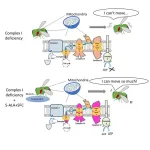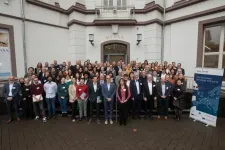(Press-News.org)
Researchers have cracked how a particular type of immune cell develops in the body and protects against infection and disease. And the discovery could help in the development of more preventive treatments, according to a new study.
The research, led by Murdoch Children’s Research Institute and Federation University Australia, has uncovered how these specialised white blood cells operate and can produce an immune response.
Associate Professor Dan Pellicci said by understanding the function of these cells, they could be harnessed to help prevent cancer and highly infectious diseases such as COVID-19, Strep A and tuberculosis.
Published in Science Immunology, the study involved samples donated to the Melbourne Children’s Heart Tissue Bank from heart surgery patients up to 16 years old. From these samples, the researchers looked at the role of ‘gamma delta T cells’ within the thymus gland, a small organ located within the chest, close to the heart.
Associate Professor Pellicci said the study showed for the first time how this organ produced these infection-fighting immune cells.
“We have large numbers of these specialised cells in our blood and tissues, which accumulate as we become adults. Until our study, it was unclear how these cells develop in the body,” he said.
“We have shown how these cells are trained over three stages, similar to receiving a primary, secondary and tertiary education, and fully formulate within the thymus. Following this education, the cells are ready to enter the rest of the body and are completely capable of fighting infections.”
Associate Professor Pellicci said previous studies suggested that these immune cells were mainly derived in the liver during a baby’s development in the womb, but this research debunked that theory.
“Many experts assumed that after birth, the thymus played little role in the development of these cells as we age, but we now know this little unsung organ helps the body prepare for a lifetime of good health,” he said.
“The more we know about these cells the greater the likelihood of unlocking new ways to treat infectious diseases and cancer.”
Researchers from the University of Melbourne, The Fiona Elsey Cancer Research Institute, Federation University, Peter Doherty Institute for Infection and Immunity, Melbourne Centre for Cardiovascular Genomics and Regenerative Medicine, The Royal Children’s Hospital and the Walter and Eliza Hall Institute of Medical Research also contributed to the findings.
Publication: Louis Perriman, Naeimeh Tavakolinia, Sedigheh Jalali, Shou Li, Peter F Hickey, Daniela Amann-Zalcenstein, William Wing Ho, Tracey M Baldwin, Adam T Piers, Igor E Kostantinov, Jeremy Anderson, Edouard G Stanley, Paul V Licciardi, George Kannourakis, Shalin H Naik, Hui-Fern Koay, Laura K Mackay, Stuart P Berzins and Daniel G Pellicci, ‘A three-stage developmental pathway for human Vγ9Vδ2 T cells within the postnatal thymus,’ Science Immunology. DOI: 10.1126/sciimmunol.abo4365
*The content of this communication is the sole responsibility of the Murdoch Children’s and does not reflect the views of the NHMRC.
Available for interview:
Associate Professor Daniel Pellicci, Murdoch Children’s, Group Leader, Cellular Immunology
END
Criegee intermediates are produced in the ozonolysis of unsaturated compounds in the atmosphere. These intermediates are especially importanct because they contribute to the formation of OH radical during the night and to formation of secondary organic aerosols. The OH radicals increase the oxidative capacity of the atmosphere, and the aerosols may reflect or absorb sunlight and contribute to cloud formation. Criegee intermediates also lay key roles in conversion of sulfur dioxide into sulfur trioxide, finally resulting in the formation ...
Tokyo, Japan – Scientists from Tokyo Metropolitan University have shown that 5-aminolevulinic acid (5-ALA) helps bypass deficiencies in Complex I (CI), the first in a series of protein complexes that transport electrons and help power the mitochondria. They showed that fruit flies missing the analogous protein showed improved health when given a cocktail of drugs including 5-ALA. CI deficiency is responsible for the majority of mitochondrial disorders; the team’s findings might lead to new therapies.
Mitochondrial diseases arise from problems in the mitochondria, a small organelle in cells which produces adenosine triphosphate (ATP), ...
COLUMBIA, Mo. -- When Sara Estrapala started her career as a high school paraeducator supporting students with disabilities such as autism, down syndrome, learning disorders and challenging behaviors, she quickly recognized a challenge — her teenage students desire to make their own decisions and their teachers’ struggle to keep them engaged and following directions.
Now an assistant research professor in the University of Missouri College of Education and Human Development, Estrapala is leading a four-year, $519,939 early career development and mentoring ...
Oceanic islands provide useful models for ecology, biogeography and evolutionary research. Many ground-breaking findings – including Darwin's theory of evolution – have emerged from the study of species on islands and their interplay with their living and non-living environment. Now, an international research team led by the University of Göttingen has investigated the flora of the Canary Island of Tenerife. The results were surprising: the island's plant-life exhibits a remarkable diversity ...
The European university network Enlight has been renewed: the EU has funded the Enlight Network consisting of the University of Göttingen with nine other research-oriented universities for four more years with a total of around 14.4 million euros. The Network plans to use a large part of the funds for academic initiatives, underlining its commitment to supporting researchers and students. In addition to the University of Göttingen, the Network includes the Universities of Ghent, Groningen, Uppsala and Tartu, the University of the Basque Country, the Universities of Bordeaux and Galway as well as Comenius University Bratislava; and Enlight's tenth and ...
The discovery that football players were unknowingly acquiring permanent brain damage as they racked up head hits throughout their professional careers created a rush to design better head protection. One of these inventions is nanofoam, the material on the inside of football helmets.
Thanks to mechanical and aerospace engineering associate professor Baoxing Xu at the University of Virginia and his research team, nanofoam just received a big upgrade and protective sports equipment could, too. This newly invented design integrates nanofoam with “non-wetting ionized liquid," a ...
The range of COVID-19 symptoms varies—some feel a mild cold, others are hospitalized, while others perish. Many studies have linked the severity of COVID-19 symptoms with an individual’s biological factors, but less is known about the impact of non-biological factors, such as the environment in which people live.
A new study that published on June 14, 2023, in the journal PLoS ONE, is the first to show that the neighborhood-built environment might pose an independent risk determining the individuals hospitalized due to COVID-19 illness.
The authors found that in a cohort of more than 18,000 individuals with SARS-CoV-2 infections, living in ...
Many landscapes in the tropics consist of a mosaic of different types of land use. How people make use of these different ecosystems, with their particular plant communities, was unclear until now. Researchers, many of them from Madagascar, have now investigated this in an interdisciplinary Malagasy research project at the University of Göttingen. When considering biodiversity, forests often get the most attention. But this research shows that rural households use a wide range of plant species ...
Neuroscientists from the Faculty of Medicine of the Catholic University, Rome Campus, and the A. Gemelli IRCCS Polyclinic Foundation found that intensive exercise could slow the course of Parkinson's disease and described the biological mechanisms. The finding could pave the way for new non-drug approaches.
The study "Intensive exercise ameliorates motor and cognitive symptoms in experimental Parkinson's disease by restoring striatal synaptic plasticity" is published in the journal Science Advances. The research was led by Catholic University, Rome Campus ...
Using an approach based on computer vision technology, researchers can work back from COVID-19 mortality data to see how infection rates changed on the day a lockdown or similar measure was introduced. The approach could be generally useful in future epidemics and pandemics. The work is published July 14 in Science Advances.
Coauthors Leonor Saiz, professor of biomedical engineering at the University of California, Davis, and Jose Vilar, University of the Basque Country, Spain, wanted to see the effects of non-pharmaceutical interventions such as social distancing, lockdowns and masking in the first year of the pandemic. They looked at daily death reports from European ...







